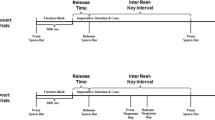Abstract
A vast body of research suggests that the primary motor cortex is involved in motor imagery. This raises the issue of inhibition: how is it possible for motor imagery not to lead to motor execution? Bach et al. (Psychol Res Psychol Forschung. 10.1007/s00426-022-01773-w, 2022, this issue) suggest that the motor execution threshold may be “upregulated” during motor imagery to prevent execution. Alternatively, it has been proposed that, in parallel to excitatory mechanisms, inhibitory mechanisms may be actively suppressing motor output during motor imagery. These theories are verbal in nature, with well-known limitations. Here, we describe a toy-model of the inhibitory mechanisms thought to be at play during motor imagery to start disentangling predictions from competing hypotheses.


Similar content being viewed by others
Availability of data and materials
An interactive Shiny application allowing to visualise the predictions of the model is available at: https://barelysignificant.shinyapps.io/motor_imagery_inhibition_model/. An R package providing helper functions to fit the model and visualise its predictions is available at: https://github.com/lnalborczyk/momimi.
Notes
Here “trial” refers to a prototypical trial in the action-mode switching paradigm (Rieger et al., 2017), where participants have to perform motor imagery and indicate the onset (reaction time) and duration (movement time) of motor imagery via a response button.
This argument holds for any activation function that increases until a certain point in time and then decreases, and therefore is not specific to the lognormal activation function.
References
Bach, P., Frank, C., & Kunde, W. (2022). Why motor imagery is not really motoric: Towards a re-conceptualization in terms of effect-based action control. Psychological Research Psychologische Forschung. https://doi.org/10.1007/s00426-022-01773-w
Bart, V. K. E., Koch, I., & Rieger, M. (2020). Inhibitory mechanisms in motor imagery: Disentangling different forms of inhibition using action mode switching. Psychological Research Psychologische Forschung, 85(4), 1418–1438. https://doi.org/10.1007/s00426-020-01327-y
Bart, V. K. E., Koch, I., & Rieger, M. (2021a). Decay of inhibition in motor imagery. Quarterly Journal of Experimental Psychology, 74(1), 77–94. https://doi.org/10.1177/1747021820949388
Bart, V. K. E., Koch, I., & Rieger, M. (2021b). Expectations affect the contribution of tonic global inhibition, but not of phasic global inhibition to motor imagery. Journal of Experimental Psychology: Human Perception and Performance, 47(12), 1621–1646. https://doi.org/10.1037/xhp0000961
Berthoz, A. (1996). The role of inhibition in the hierarchical gating of executed and imagined movements. Cognitive Brain Research, 3(2), 101–113. https://doi.org/10.1016/0926-6410(95)00035-6
Dendauw, E., Evans, N. J., Logan, G. D., Gajdos, T., Haffen, E., Bennabi, D., & Servant, M. (2023). The gated cascade diffusion model: An integrated theory of decision-making, motor preparation, and motor execution [Preprint]. PsyArXiv. https://doi.org/10.31234/osf.io/dxsjh
Guillot, A., Di Rienzo, F., MacIntyre, T., Moran, A., & Collet, C. (2012). Imagining is not doing but involves specific motor commands: A review of experimental data related to motor inhibition. Frontiers in Human Neuroscience, 6, 141. https://doi.org/10.3389/fnhum.2012.00247
Jeannerod, M. (2001). Neural simulation of action: A unifying mechanism for motor cognition. NeuroImage, 14(1), S103–S109. https://doi.org/10.1006/nimg.2001.0832
MacDonald, H. J., Coxon, J. P., Stinear, C. M., & Byblow, W. D. (2014). The fall and rise of corticomotor excitability with cancellation and reinitiation of prepared action. Journal of Neurophysiology, 112(11), 2707–2717. https://doi.org/10.1152/jn.00366.2014
MacDonald, H. J., McMorland, A. J. C., Stinear, C. M., Coxon, J. P., & Byblow, W. D. (2017). An activation threshold model for response inhibition. PLoS ONE, 12(1), e0169320. https://doi.org/10.1371/journal.pone.0169320
Pereira, M., Perrin, D., & Faivre, N. (2022). A leaky evidence accumulation process for perceptual experience. Trends in Cognitive Sciences, 26(6), 451–461. https://doi.org/10.1016/j.tics.2022.03.003
Rieger, M., Dahm, S. F., & Koch, I. (2017). Inhibition in motor imagery: A novel action mode switching paradigm. Psychonomic Bulletin & Review, 24(2), 459–466. https://doi.org/10.3758/s13423-016-1095-5
Servant, M., Logan, G. D., Gajdos, T., & Evans, N. J. (2021). An integrated theory of deciding and acting. Journal of Experimental Psychology: General, 150(12), 2435–2454. https://doi.org/10.1037/xge0001063
Smaldino, P. E. (2020). How to translate a verbal theory into a formal model. Social Psychology, 51(4), 207–218. https://doi.org/10.1027/1864-9335/a000425
van Rooij, I., & Blokpoel, M. (2020). Formalizing verbal theories: A tutorial by dialogue. Social Psychology, 51(5), 285–298. https://doi.org/10.1027/1864-9335/a000428
Funding
We want to thank Camille Grasso for insightful comments at various stages of the present research. This work, carried out within the Institute of Convergence ILCB (ANR-16-CONV-0002), has benefited from support from the French government (France 2030), managed by the French National Agency for Research (ANR) and the Excellence Initiative of Aix-Marseille University (A*MIDEX). A CC-BY 4.0 public copyright license (https://creativecommons.org/licenses/by/4.0/) has been applied by the authors to the present document, in accordance with the grant’s open access conditions.
Author information
Authors and Affiliations
Contributions
Conceptualization: LN, ML, TG, MS, FXA; data curation: LN; formal analysis: LN, TG; funding acquisition: LN, ML, TG, MS, FXA; investigation: LN, ML, TG, MS, FXA; methodology: LN, ML, TG, MS, FXA; project administration: LN, ML, FXA; resources: LN, ML, TG, MS, FXA; software: LN, TG; supervision: ML, TG, MS, FXA; validation: ML, TG, MS, FXA; visualization: LN; writing—original draft: LN; writing—review and editing: LN, ML, TG, MS, FXA.
Corresponding author
Ethics declarations
Competing interests
The authors declare no competing interests.
Ethical approval
Not applicable.
Additional information
Publisher's Note
Springer Nature remains neutral with regard to jurisdictional claims in published maps and institutional affiliations.
Rights and permissions
Springer Nature or its licensor (e.g. a society or other partner) holds exclusive rights to this article under a publishing agreement with the author(s) or other rightsholder(s); author self-archiving of the accepted manuscript version of this article is solely governed by the terms of such publishing agreement and applicable law.
About this article
Cite this article
Nalborczyk, L., Longcamp, M., Gajdos, T. et al. Towards formal models of inhibitory mechanisms involved in motor imagery: a commentary on Bach et al. (2022). Psychological Research (2024). https://doi.org/10.1007/s00426-023-01915-8
Received:
Accepted:
Published:
DOI: https://doi.org/10.1007/s00426-023-01915-8




